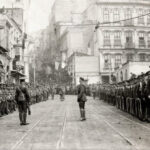What Happened to Japanese POWs Captured by the Russians During WWII?
What Happened to Japanese POWs Captured by the Russians During WWII? During World War II, a significant number of Japanese soldiers were captured by the Soviet Union, especially in the final stages of the war. After Japan’s surrender in August 1945, the Soviet Union launched an offensive against Japanese forces in Manchuria (northeast China), Korea, and other areas, capturing approximately 500,000 to 600,000 Japanese military personnel and civilians.
Here’s what happened to them:
Forced Labor in Siberia and Soviet Central Asia:
Most Japanese POWs were transported to labor camps in Siberia, Kazakhstan, and other regions of the Soviet Union. They were forced to work in mines, factories, and on construction projects, especially rebuilding areas destroyed during the war. The work was often harsh and in extremely cold, unforgiving conditions.
Conditions in these camps were harsh, and the death rate among POWs was high due to malnutrition, illness, and overwork. It is estimated that between 10% and 15% of the POWs died while in Soviet custody.
Repatriation:
Repatriation of Japanese POWs did not happen immediately after the war. It took several years for the Soviet Union to begin sending POWs back to Japan. The process started in 1947 and continued until 1956, with the last group of POWs being released more than a decade after the end of WWII.
By 1956, about 55,000 Japanese POWs were still being held in the Soviet Union, with the majority having been returned earlier. The lengthy internment of Japanese POWs in the USSR became a point of tension between Japan and the Soviet Union during the post-war period.
Political Use:
The Soviet Union used the Japanese POWs as political leverage during negotiations with Japan and the broader geopolitical dynamics of the Cold War. The treatment of Japanese POWs became part of the broader narrative of Soviet-Japanese relations.
Some POWs were subject to communist indoctrination programs, with a small number becoming pro-Soviet and staying in the USSR, although this was relatively rare.
Post-Release Life:
Many of the POWs who returned to Japan faced social stigma and challenges reintegrating into society. Some families assumed they had died during the war. The long absence created emotional and psychological strains for both the soldiers and their families.
The fate of Japanese POWs captured by the Soviets stands in stark contrast to the treatment of Japanese POWs held by other Allied nations, particularly in terms of the length of internment and the harsh conditions they endured in Soviet labor camps.


